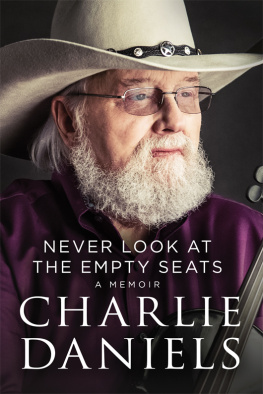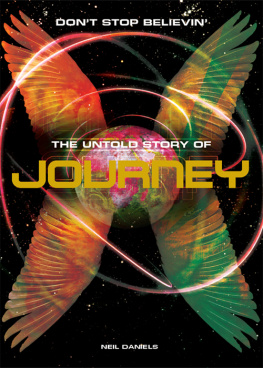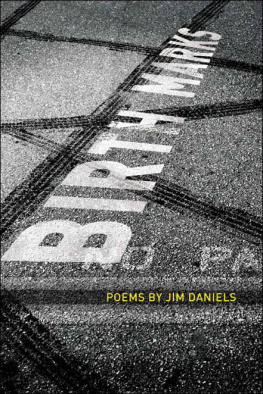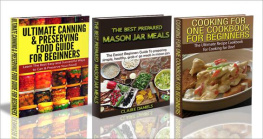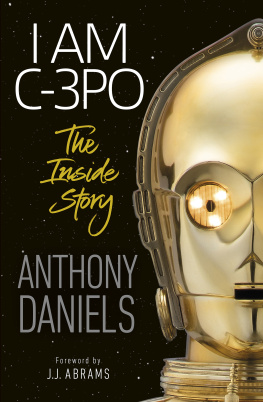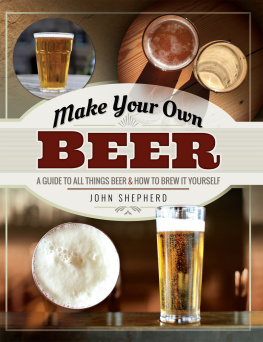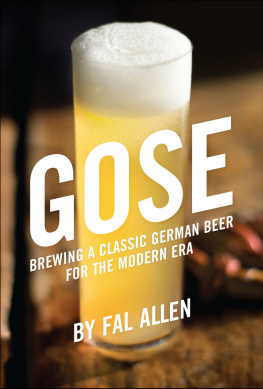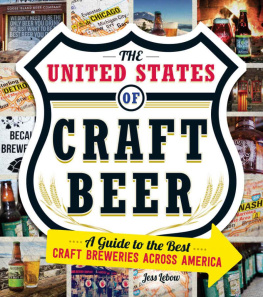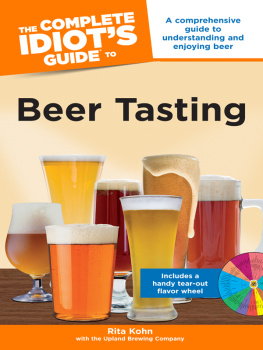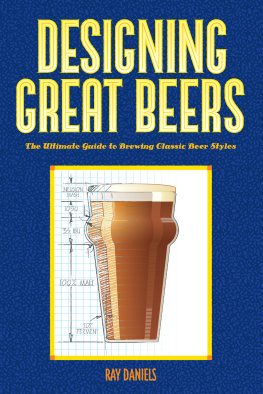Daniels - Designing Great Beers: The Ultimate Guide to Brewing Classic Beer Styles
Here you can read online Daniels - Designing Great Beers: The Ultimate Guide to Brewing Classic Beer Styles full text of the book (entire story) in english for free. Download pdf and epub, get meaning, cover and reviews about this ebook. publisher: Brewers Publications, genre: Home and family. Description of the work, (preface) as well as reviews are available. Best literature library LitArk.com created for fans of good reading and offers a wide selection of genres:
Romance novel
Science fiction
Adventure
Detective
Science
History
Home and family
Prose
Art
Politics
Computer
Non-fiction
Religion
Business
Children
Humor
Choose a favorite category and find really read worthwhile books. Enjoy immersion in the world of imagination, feel the emotions of the characters or learn something new for yourself, make an fascinating discovery.
- Book:Designing Great Beers: The Ultimate Guide to Brewing Classic Beer Styles
- Author:
- Publisher:Brewers Publications
- Genre:
- Rating:5 / 5
- Favourites:Add to favourites
- Your mark:
- 100
- 1
- 2
- 3
- 4
- 5
Designing Great Beers: The Ultimate Guide to Brewing Classic Beer Styles: summary, description and annotation
We offer to read an annotation, description, summary or preface (depends on what the author of the book "Designing Great Beers: The Ultimate Guide to Brewing Classic Beer Styles" wrote himself). If you haven't found the necessary information about the book — write in the comments, we will try to find it.
Designing Great Beers: The Ultimate Guide to Brewing Classic Beer Styles — read online for free the complete book (whole text) full work
Below is the text of the book, divided by pages. System saving the place of the last page read, allows you to conveniently read the book "Designing Great Beers: The Ultimate Guide to Brewing Classic Beer Styles" online for free, without having to search again every time where you left off. Put a bookmark, and you can go to the page where you finished reading at any time.
Font size:
Interval:
Bookmark:


Brewers Publications
A Division of the Brewers Association
PO Box 1679, Boulder, CO 80306-1679
(303) 447-0816
BrewersAssociation.org
1996, 2000 by Ray Daniels
All rights reserved. Except for use in a review, no portion of this book may be reproduced in any form without written permission of the publisher. Neither the author, editors, nor the publisher assumes any responsibility for the use or misuse of information contained in this book.
ISBN-13: 978-0-937381-50-2 (print)
ISBN-10: 0-937381-50-0 (print)
Library of Congress Cataloging-in-Publication Data (print)
Daniels, Ray.
Designing Great Beers / Ray Daniels.
p. cm.
Includes bibliographical references and index.
IBSN 0-937381-50-0 (alk. paper)
1. Beer. 2. Brewing. I. Title.
TP577.D26 1996
663'.42dc20 96-30660
CIP
Technical Editor: Paul Farnsworth
Book Project Editor: Theresa Duggan
Copy Editor: Dianne Russell
Cover Designer: Randy Mosher/Randy Mosher Design
Interior Designer: Wendy Lyons
FIGURES
TABLES
Introduction

No book is possible without the help of many individuals. In this case, all of the people who helped out were knowledgeable about and interested in beer, and that made working with them all the more pleasant.
I must start by thanking Steve Castleman of Californias Maltose Falcons. Steve suggested to me and to Brewers Publications that a book like Designing Great Beers would be a worthy undertaking. I also thank his wife, Maribeth Raines, who shared her time and expertise with me.
Two other people who profoundly affected this book, also deserve early mention. The first is Randy Mosher. His unselfish sharing of all that he knows, not only with me but with anyone interested in beer, has catalyzed many of the accomplishments made by brewers associated with the Chicago Beer Society. Without him, neither this book nor my own understanding of beer would be what it is today. While you will find his name mentioned frequently in the text and credits, his influence extends much further. The second is my technical editor, Paul Farnsworth. His in-depth scientific knowledge and practical brewing experience, in both Britain and the United States, brought valuable objectivity to the manuscript. Through more than twenty years of writing for publication, I have worked with a lot of editors. I only wish all of them had been as careful and constructive as Paul.
Next, Ill thank the U.S. postal service for (again) clearly demonstrating that private or electronic means should be used for all important communications. In August 1993, I wrote a proposal for this book and sent it to Elizabeth Gold, Publisher of Brewers Publications. She sent a letter back expressing interest in the project, but I never got it. Thinking that there was no interest in the book, I turned my attention to other priorities. When I saw Elizabeth the following April, she surprised me by saying, Hows the book going? My reply, What book? Im sure was no less surprising to her. By the time we sorted everything out and I started work on the book, it had been over a year since my original proposal.
The first place I went for information was the library at the Siebel Institute in Chicago, which has an extensive catalog of both current and historical brewing literature. Bill Siebel was kind enough to allow me regular access to this treasure trove. For more than a year, many others at Siebel, including Linda Peek, Jackie Kelly, and Maureen Miller, also assisted me. The schools brewer-turned-registrar, Christopher Bird, served as host during many of my visits and was constantly supportive and helpful.
Not long after my visits to Siebel began, I wound up enrolling in their ten-week diploma course on brewing. Work on my brewery project had hit an unexpected snag, and so it seemed like a good time to invest in a little formal brewing education. Of course, the book benefited from this experience as well; my fellow classmates contributed unique perspectives on brewing that furthered my understanding of beer science and practice.
The faculty at Siebel is fantastic. Many of the lectures and informal discussions contributed either directly or indirectly to this book. I want to thank Dr. Joe Power for taking the time to talk with me on many occasions about technical issues, Klaus Zastrow for helping me decode old German brewing texts as well as imparting his knowledge of beer history and brewing science, Paul Smith for his comprehensive insight into the issues of beer color and specialty malts, Jim Helmke for sharing his vast expertise in modern brewing science, and Ilse Shelton for further training my palate. I also want to thank Kurt Duecker of Schreier Malt for providing me and my classmates with a thorough understanding of the malting process and its relationship to finished beer quality. Finally, under sponsorship from Bill Siebel, the Siebel laboratory ran a couple of IBU analyses for me to help provide data for the hop section of this book. This contribution was greatly appreciated.
Of course, Siebel was not my only resource. A number of others shared their time and expertise with me on hop issues alone, including Max L. Deinzer at Oregon State University, and fellow brewers Mark Garetz, Glenn Tinseth, and Al Korzonas.
Many people provided guidance and advice during my research of beer color. In addition to Joe Power and Paul Smith of Siebel, I received valuable input from Keith Thomas of Brewlab at the University of Sunderland in England, food technologist Terri Paeschke, Marianne Gruber at Briess Malting, and also Ilse Shelton and Jim Helmke at Siebel. Thanks also to Greg Noonan for steering me toward a needed correction after the color material was published in Brewing Techniques.
During a trip to England while writing the style sections, I learned a good deal from both brewers and beer drinkers. Geoff Cooper shared his knowledge of British styles over a number of pints, as did others, including Mr. Barry Pepper. Mark Dorber, landlord of the White Horse Pub, shared his knowledge of cellarmanship as well as a few tips on sources of historical brewing books. Keith Thomas facilitated further discovery of the British styles through a series of conversations.
During the London trip, I spent a good deal of productive time talking with James Spence of the American Homebrewers Association about beer styles. James later arranged for me to acquire a copy of the 500 Bier Aus Aller Welt series from Charlie Papazians library. A big thanks to both Charlie and James for that resource.
In addition to the Siebel collection, I studied many other old brewing texts. I was able to acquire a number of these for my personal collection thanks to book collector Steve Presley and beer history buff Pete Slosberg. Of course, several references came from the personal library of Randy Mosher.
Others who helped include Steve Hamburg, Dennis Davison, Chris Nemeth, Todd McGuiness, and Dan McConnell.
The Association of Brewers has contributed to this book in various ways. Thanks to Karen Barela and the AHA for contributing the second-round entry forms for analysis and to Bill Simpson for making copies of those forms. Thanks to the Great American Beer Festival and the Institute for Brewing Studies for conducting events that allowed me to learn more about beers and brewing methods in the United States today.
Next pageFont size:
Interval:
Bookmark:
Similar books «Designing Great Beers: The Ultimate Guide to Brewing Classic Beer Styles»
Look at similar books to Designing Great Beers: The Ultimate Guide to Brewing Classic Beer Styles. We have selected literature similar in name and meaning in the hope of providing readers with more options to find new, interesting, not yet read works.
Discussion, reviews of the book Designing Great Beers: The Ultimate Guide to Brewing Classic Beer Styles and just readers' own opinions. Leave your comments, write what you think about the work, its meaning or the main characters. Specify what exactly you liked and what you didn't like, and why you think so.


